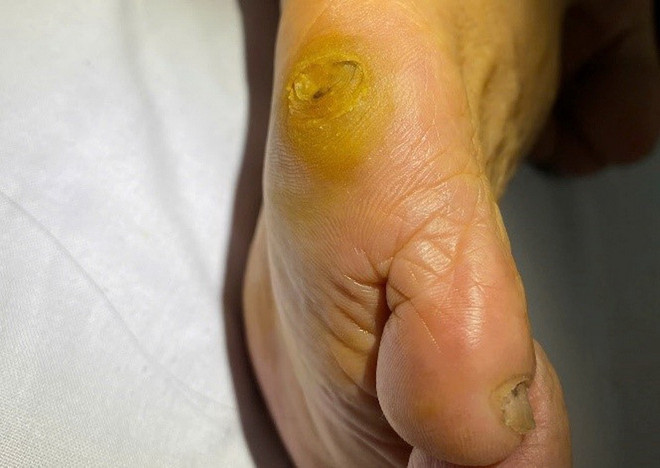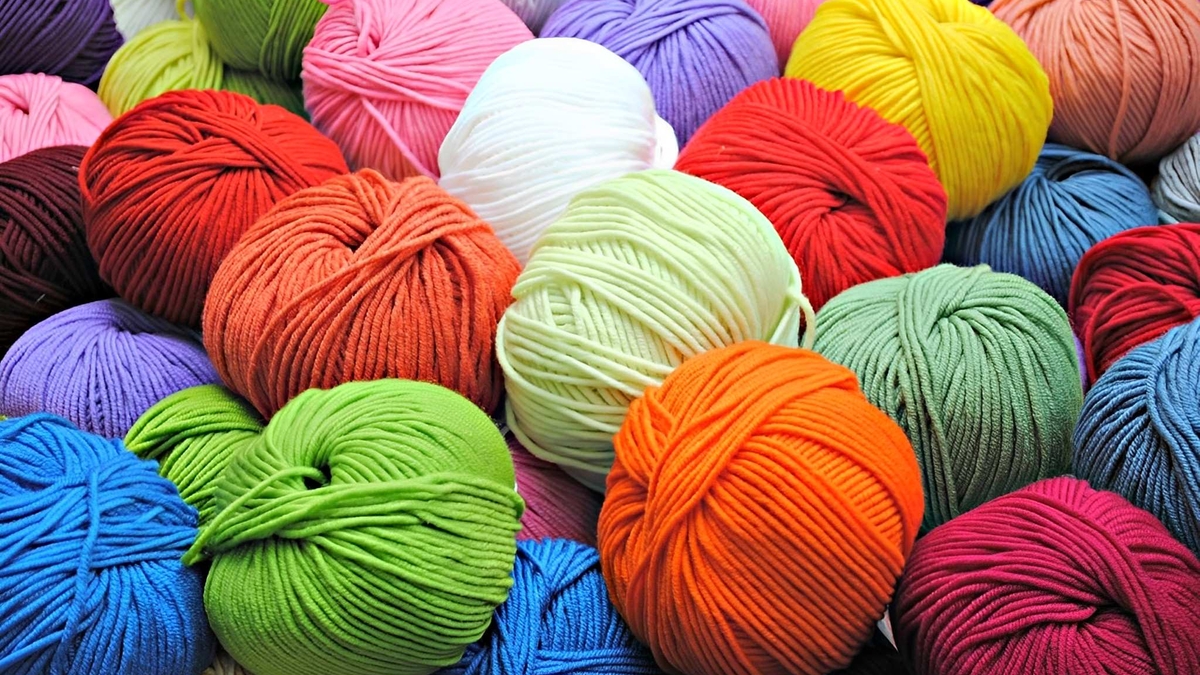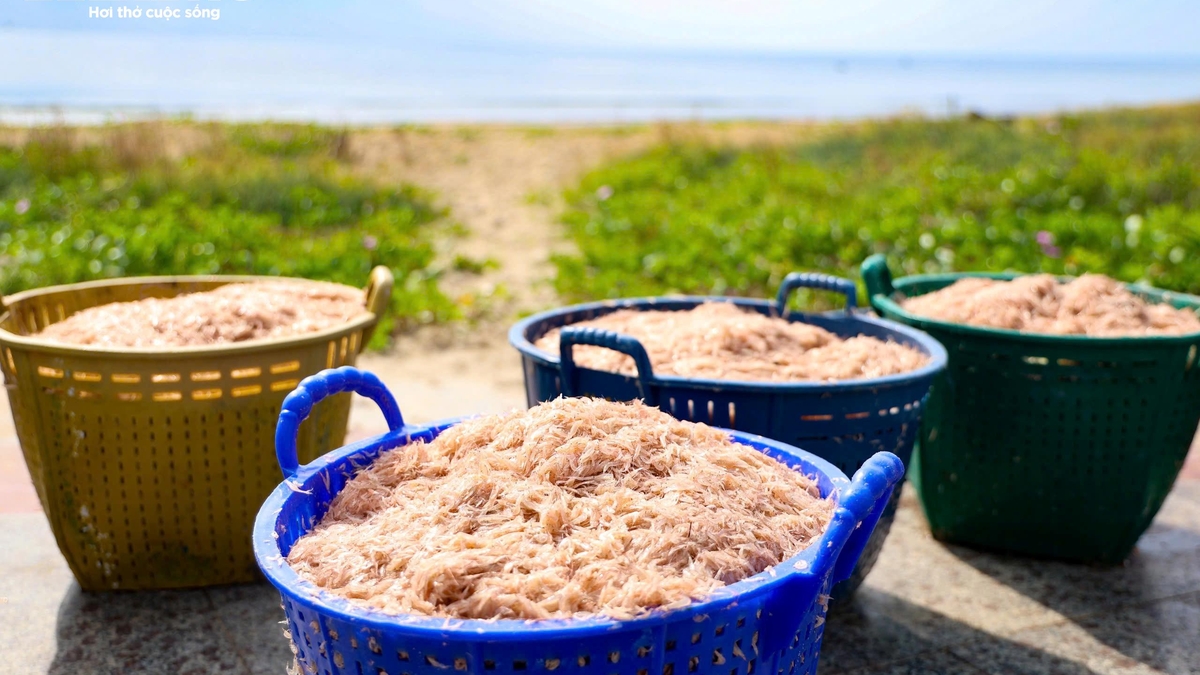Among the diseases that cause foot pain, calluses are the most common cause, affecting 14-48% of the population.
Although calluses are a benign injury, they can cause reduced mobility and a decrease in quality of life.
In March 2025, 108 Military Central Hospital received and treated a 78-year-old female patient with calluses on her feet causing pain and difficulty walking.
A 78-year-old female patient had a lesion located in the little tissue of the right sole, measuring 3x4cm, calloused, rigid, and had been developing for many years, causing the patient a lot of pain and difficulty walking.
The patient was carefully examined by the doctors, no warts were found, and the lesion was subsequently removed with a scalpel in the operating room and instructions for home care were given to prevent recurrence.
What is a callus?
Foot calluses. (Source: 108 Central Military Hospital)
Calluses are areas of thickened, hardened skin that are different in color from the rest of the skin. They often appear in areas that are subjected to a lot of pressure, such as the heels, toes, ankles, and soles of the feet.
Calluses can range in size from a few millimeters to several centimeters. They can thicken, become larger, and become darker over time if not treated promptly.
Causes of calluses
Calluses form over a long period of time due to reasons such as:
Wearing shoes that are too tight causes the skin of the feet to be affected by friction over time, the toes are compressed, leading to calluses.
The habit of sitting cross-legged for a long time can easily lead to calluses near the ankles.
Calluses are sometimes a manifestation of diseases such as diabetes, bone and joint diseases, liver dysfunction, endocrine-related diseases...
Why do calluses hurt?
In most cases, calluses are only unsightly and uncomfortable, but sometimes they are painful.
This is when the callus has a hard core in the middle. They are conical in shape with the base at the skin surface so we see it normally with the eyes. But the tip of the cone is pointed inward, compressing the surrounding tissues and nerves, causing severe pain. There are also cases where the callus causes local inflammation and pain.
When should I see a doctor?
Most calluses are benign and not too serious. Sometimes it causes pain and discomfort when moving or pressing a lot. However, some cases of calluses can warn of the disease that we are suffering from. In that case, you should see a specialist for timely examination.
Calluses often appear in diabetic patients with deformed feet. In this case, you should see an endocrinologist for advice on daily foot care.
Regular pressure not only causes calluses but can also affect the joints. At this time, you will see the fingers in the calloused area become abnormally deformed. If you notice deformed fingers or toes, you should see a musculoskeletal doctor for timely treatment.
In addition, when the callus shows signs of ulceration, severe pain or pus discharge, it may be infected. In that case, you should see a doctor to have the callus examined and cleaned.
How to treat calluses?
Calluses that make you uncomfortable when doing daily activities or working should be treated. However, the best way is to determine the cause of your calluses and change that habit. For example, you wear shoes that are too tight or often carry heavy loads. Changing these bad habits will help prevent calluses from getting thicker.
One of the ways to treat calluses is surgery. We only operate on calluses that are too large and painful. In that case, the surgeon will use a scalpel to cut away the thickened skin. This method is usually painless and you can walk immediately after.
You can also treat calluses at home by:
- Soak your feet in warm water for 5-10 minutes or until the skin is soft. This will help the skin to soften and peel off when gently wiped with a dry towel.
- Use a pumice stone dipped in warm water and gently file the callus. This also helps remove dead skin cells in the calloused area. Be careful to file gently so as not to remove too much skin to prevent bleeding or infection.
- Apply moisturizers containing ingredients such as Salicylic acid, Ammoium lactate or Urea. These active ingredients will help soften calluses gradually.
- Use pads to protect calluses from irritation from everyday activities.
However, if home remedies are not effective, you should see a doctor for proper treatment.
What can I do to prevent calluses?
We can completely prevent calluses from forming in many different ways such as:
Choose the right shoes
Choosing the right shoes that are not too tight will help prevent calluses from forming. (Source: CNN)
The most common cause of calluses is wearing shoes that are the wrong size or shape. Wearing shoes that fit properly helps prevent too much friction on your feet.
Wear socks
When wearing shoes, you should wear socks to reduce friction on your feet. Be careful to choose soft fabrics that are not too rough to protect your feet.
Don't go barefoot
To avoid foot skin friction with the ground or hard rocks leading to injury.
Trim toenails regularly
Toenails that are too long will push the toes closer to the shoe. This will lead to calluses forming over time. Therefore, it is important to trim your toenails properly and regularly.
Protect your hands
Use gloves when carrying heavy objects or doing work that involves friction.
Hand and foot care. Hands and feet are often subjected to a lot of pressure in daily activities. Therefore, we should take care of them regularly to prevent calluses from forming. Soak your hands or feet in warm water, then dry and apply moisturizer. This helps soften the skin on your hands and feet, preventing calluses./.
(Vietnam+)
Source: https://www.vietnamplus.vn/vi-sao-chai-chan-lai-gay-dau-nhuc-va-cach-xu-ly-phong-ngua-hieu-qua-post1041355.vnp




![[Photo] Prime Minister Pham Minh Chinh meets with South African President Matamela Cyril Ramaphosa](https://vphoto.vietnam.vn/thumb/1200x675/vietnam/resource/IMAGE/2025/10/23/1761226081024_dsc-9845-jpg.webp)



![[Photo] President Luong Cuong holds talks with South African President Matamela Cyril Ramaphosa](https://vphoto.vietnam.vn/thumb/1200x675/vietnam/resource/IMAGE/2025/10/23/1761221878741_ndo_br_1-8416-jpg.webp)
![[Photo] Prime Minister Pham Minh Chinh chairs meeting on railway projects](https://vphoto.vietnam.vn/thumb/1200x675/vietnam/resource/IMAGE/2025/10/23/1761206277171_dsc-9703-jpg.webp)
































































































Comment (0)